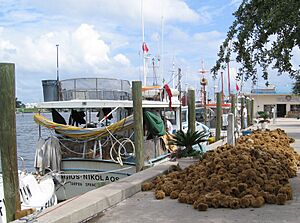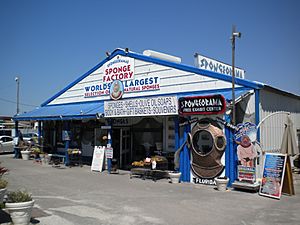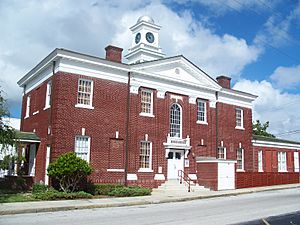Tarpon Springs, Florida facts for kids
Quick facts for kids
Tarpon Springs, Florida
|
|
|---|---|
| City of Tarpon Springs | |
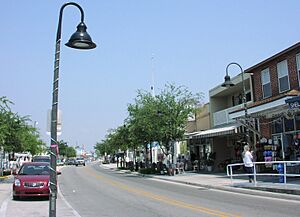
Dodecanese Avenue
|
|
| Motto(s):
Visit Greece Without Leaving Florida
|
|
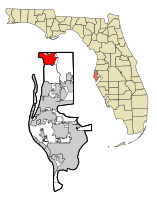
Location in Pinellas County and the state of Florida
|
|
| Country | United States |
| State | Florida |
| County | Pinellas |
| Settled | 1876 |
| Incorporated (city) | 1887 |
| Government | |
| • Type | Commission–Manager |
| Area | |
| • Total | 17.93 sq mi (46.44 km2) |
| • Land | 9.26 sq mi (23.98 km2) |
| • Water | 8.67 sq mi (22.46 km2) |
| Elevation | 23 ft (7 m) |
| Population
(2020)
|
|
| • Total | 25,117 |
| • Density | 2,712.42/sq mi (1,047.31/km2) |
| Time zone | UTC-5 (Eastern (EST)) |
| • Summer (DST) | UTC-4 (EDT) |
| ZIP codes |
34688, 34689
|
| Area code(s) | 727 |
| FIPS code | 12-71150 |
| GNIS feature ID | 0292048 |
Tarpon Springs is a city in Pinellas County, Florida, United States. It is famous for its rich Greek heritage and sponge diving history. The city is part of the Tampa Bay area. In 2020, about 25,117 people lived there.
Tarpon Springs has the highest number of Greek Americans in any U.S. city. In 2000, 10.4% of its residents had Greek family roots.
Contents
History of Tarpon Springs
The area around Tarpon Springs was settled by farmers and fishermen around 1876. They saw many tarpon fish jumping out of the water. This led them to name the place Tarpon Springs. An early settler, Mrs. Ormond Boyer, is said to have named it. She saw fish leaping and said, "See the tarpon spring!" Most of the fish she saw were actually mullet, not tarpon.
In 1882, Hamilton Disston bought the land and planned the town. On February 12, 1887, Tarpon Springs became the first city in what is now Pinellas County. A year later, the first railroad line arrived. Wealthy people from the north started visiting the area for winter vacations.
The city's Rose Cemetery is a historic burial ground for Black residents. Burials there began in the late 1800s. The cemetery includes the grave of Richard Quarls, a veteran of the American Civil War.
The Sponge Industry
In the 1880s, John K. Cheyney started the first local sponge business. The industry grew quickly in the 1890s. Many people from Key West and the Bahamas moved to Tarpon Springs. They came to harvest and process sponges. Some Greek immigrants also arrived to work in this growing industry.
In 1905, John Cocoris brought a new method to Tarpon Springs. He introduced sponge diving by bringing divers from Greece. The first divers came from the islands of Aegina and Hydra. Soon, more divers arrived from the Dodecanese islands like Kalymnos, Symi, and Halki. The sponge industry quickly became very important for Florida. It was the biggest business in Tarpon Springs, making millions of dollars each year. The 1953 movie Beneath the 12-Mile Reef was filmed here. It showed the exciting world of sponge diving.
In 1947, a red tide algae bloom destroyed the sponge fields. Many sponge boats and divers had to switch to shrimping. Others left the business entirely. Over time, the sponges grew back. Today, there is still a smaller but steady sponge industry. In the 1980s, the business grew again. This happened because a disease affected sponges in the Mediterranean Sea.
Geography and Climate
Tarpon Springs is located in Florida. It has a total area of about 16.9 square miles (43.8 square kilometers). About 9.1 square miles (23.6 square kilometers) is land. The rest, about 7.7 square miles (19.9 square kilometers), is water.
Weather in Tarpon Springs
Tarpon Springs has warm weather all year. It has a humid subtropical and tropical savanna feel. Winters are mild, with daytime temperatures around 69 to 72°F (21-22°C). Night temperatures are usually 50 to 54°F (10-12°C). It rarely freezes, and snowfall is extremely rare.
Summers are hot and very humid. Afternoon thunderstorms are common. These storms can sometimes bring hail or even tornadoes and waterspouts from the Gulf of Mexico. Daytime temperatures are usually 89 to 91°F (32-33°C). Temperatures over 100°F (38°C) are very rare. Spring and fall seasons are generally warm and pleasant.
| Climate data for Tarpon Springs, Florida (Tarpon Springs Sewage Plant), 1991–2020 normals, extremes 1892–present | |||||||||||||
|---|---|---|---|---|---|---|---|---|---|---|---|---|---|
| Month | Jan | Feb | Mar | Apr | May | Jun | Jul | Aug | Sep | Oct | Nov | Dec | Year |
| Record high °F (°C) | 90 (32) |
97 (36) |
92 (33) |
95 (35) |
100 (38) |
100 (38) |
102 (39) |
99 (37) |
99 (37) |
96 (36) |
93 (34) |
89 (32) |
102 (39) |
| Mean maximum °F (°C) | 81.7 (27.6) |
82.5 (28.1) |
85.9 (29.9) |
89.4 (31.9) |
92.4 (33.6) |
94.8 (34.9) |
95.3 (35.2) |
95.3 (35.2) |
94.0 (34.4) |
90.5 (32.5) |
86.1 (30.1) |
82.4 (28.0) |
96.4 (35.8) |
| Mean daily maximum °F (°C) | 69.3 (20.7) |
72.0 (22.2) |
76.0 (24.4) |
81.1 (27.3) |
86.2 (30.1) |
89.7 (32.1) |
90.6 (32.6) |
90.8 (32.7) |
88.9 (31.6) |
83.8 (28.8) |
76.3 (24.6) |
71.4 (21.9) |
81.4 (27.4) |
| Daily mean °F (°C) | 60.0 (15.6) |
62.9 (17.2) |
66.8 (19.3) |
72.2 (22.3) |
77.6 (25.3) |
82.0 (27.8) |
83.1 (28.4) |
83.3 (28.5) |
81.3 (27.4) |
75.6 (24.2) |
67.5 (19.7) |
62.4 (16.9) |
72.9 (22.7) |
| Mean daily minimum °F (°C) | 50.7 (10.4) |
53.8 (12.1) |
57.6 (14.2) |
63.2 (17.3) |
69.1 (20.6) |
74.4 (23.6) |
75.6 (24.2) |
75.7 (24.3) |
73.6 (23.1) |
67.3 (19.6) |
58.6 (14.8) |
53.5 (11.9) |
64.4 (18.0) |
| Mean minimum °F (°C) | 32.9 (0.5) |
36.9 (2.7) |
42.0 (5.6) |
50.1 (10.1) |
59.6 (15.3) |
68.4 (20.2) |
70.6 (21.4) |
71.9 (22.2) |
66.9 (19.4) |
53.3 (11.8) |
42.7 (5.9) |
37.2 (2.9) |
30.8 (−0.7) |
| Record low °F (°C) | 19 (−7) |
20 (−7) |
23 (−5) |
34 (1) |
45 (7) |
51 (11) |
62 (17) |
63 (17) |
53 (12) |
38 (3) |
26 (−3) |
19 (−7) |
19 (−7) |
| Average precipitation inches (mm) | 3.03 (77) |
2.51 (64) |
3.08 (78) |
2.69 (68) |
2.35 (60) |
7.06 (179) |
9.05 (230) |
9.66 (245) |
7.03 (179) |
3.19 (81) |
1.90 (48) |
2.74 (70) |
54.29 (1,379) |
| Average precipitation days (≥ 0.01 in) | 9.0 | 7.4 | 7.6 | 6.1 | 6.2 | 11.3 | 15.7 | 16.2 | 12.7 | 7.5 | 5.6 | 6.7 | 112.0 |
| Source: NOAA | |||||||||||||
People of Tarpon Springs
| Historical population | |||
|---|---|---|---|
| Census | Pop. | %± | |
| 1890 | 327 | — | |
| 1900 | 541 | 65.4% | |
| 1910 | 2,212 | 308.9% | |
| 1920 | 2,105 | −4.8% | |
| 1930 | 3,414 | 62.2% | |
| 1940 | 3,402 | −0.4% | |
| 1950 | 4,323 | 27.1% | |
| 1960 | 6,768 | 56.6% | |
| 1970 | 7,118 | 5.2% | |
| 1980 | 13,251 | 86.2% | |
| 1990 | 17,906 | 35.1% | |
| 2000 | 21,003 | 17.3% | |
| 2010 | 23,484 | 11.8% | |
| 2020 | 25,117 | 7.0% | |
| U.S. Decennial Census | |||
Tarpon Springs has grown a lot over the years. In 2020, there were 25,117 people living in the city. There were 10,971 households and 6,191 families.
Arts and Culture
Tarpon Springs is famous for its strong Greek culture. This is especially true for its religious events.
Epiphany Celebration
The St. Nicholas Greek Orthodox Cathedral hosts amazing religious ceremonies. One of the most famous is the Epiphany celebration on January 6. This event includes young men diving into the water to find a cross. It also involves blessing the waters and boats. Early Greek immigrants relied on the sea for their jobs. So, this service was important to ask for divine protection for their risky work.
Many Greek Americans from all over the country visit for this celebration. The city's population can triple on this day. A high-ranking church leader, the Metropolitan of Atlanta, usually leads the blessings. The ceremony ends with a wooden cross being thrown into the city's Spring Bayou. Boys aged 16 to 18 dive in to get it. The one who finds the cross is said to have good luck for the whole year.
Visiting Tarpon Springs
Dodecanese Avenue is in the Greektown Historic District. It is a popular spot for both locals and tourists. This street follows the Anclote River. You can find many restaurants there. They serve delicious Greek cuisine and fresh seafood.
The nearby beaches are great for water fun. They are part of the Pinellas County parks. You can reach the sandy barrier islands offshore by boat. These islands are perfect for finding shells. You can also watch bottlenose dolphins playing in the water. One special island, Anclote Key, is a State Park Preserve. It has an old lighthouse, bird nesting areas, and beautiful beaches.
There are several museums to explore:
- The Tarpon Springs Heritage Museum in Craig Park shows the history of the Greek Community.
- The Cultural Center has changing exhibits about local culture.
- The Safford House Museum tells the story of one of the city's first families.
- The Depot Museum gives an overview of Tarpon Springs' history.
- The Tarpon Springs Performing Arts Center is a theater. It hosts many artists, musicians, and local plays all year.
Historic Places to See
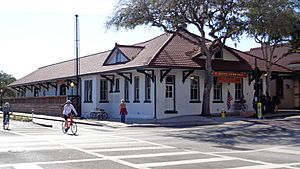
Several places in Tarpon Springs are listed on the National Register of Historic Places. This means they are important historical sites. Some of these include:
- Tarpon Springs Greektown Historic District
- Tarpon Springs Historic District
- Cycadia Cemetery
- Arcade Hotel
- Old Tarpon Springs City Hall
- Old Tarpon Springs High School
- Safford House
- Rose Hill Cemetery
- Tarpon Springs Depot
Many sites related to the sponge industry are also recognized. These include sponge packing houses and historic sponge diving boats.
Tarpon Springs Public Library
The Tarpon Springs Public Library serves the city and nearby areas. It was started in 1916 by Julia Roswell Smith Inness. The library has moved several times as the city grew. It started in City Hall, then moved to a small house. Later, new buildings were built in 1937 and 1967. In 1997, a new, larger building opened in downtown Tarpon Springs.
Media and Film
Tarpon Springs was the main filming location for the 1953 movie Beneath the Twelve-Mile Reef. The film shows the lives of Greek sponge fishermen. It also features the annual Epiphany celebration.
Important People from Tarpon Springs
Many notable people have come from Tarpon Springs:
- 2 Pistols, a rapper
- Doug Ault, a former professional baseball player
- Michael Bilirakis, a former U.S. Representative
- Gus Bilirakis, a U.S. Representative
- Chris Coghlan, a former professional baseball player
- Mason Cole, a professional football player
- Dieselboy, an electronic music artist
- Billy "The Kid" Emerson, a preacher and former musician
- Michael Koulianos, a preacher, writer, and YouTuber
- Elaine Esposito, known for holding the record for the longest coma
- Wayne Fontes, a former NFL coach
- Bertie Higgins, a singer known for "Key Largo"
- William W. Kingsbury, a former U.S. Representative
- Themistocles Leftheris, an Olympian in pairs figure skating
- Lois Lenski, a children's author who won the Newbery Medal
- Melanie Safka, a singer-songwriter
- Savatage, a heavy metal band
- Artavis Scott, a wide receiver for the Los Angeles Chargers
Sister Cities
Tarpon Springs has special "Sister City" relationships with several Greek-speaking islands. These connections honor the city's close historical ties to Greece. In 2007 and 2008, Tarpon Springs became sister cities with:
- Kalymnos, Greece
- Halki, Greece
- Symi, Greece
- Hydra, Greece
- Larnaca, Cyprus
See also
 In Spanish: Tarpon Springs para niños
In Spanish: Tarpon Springs para niños



